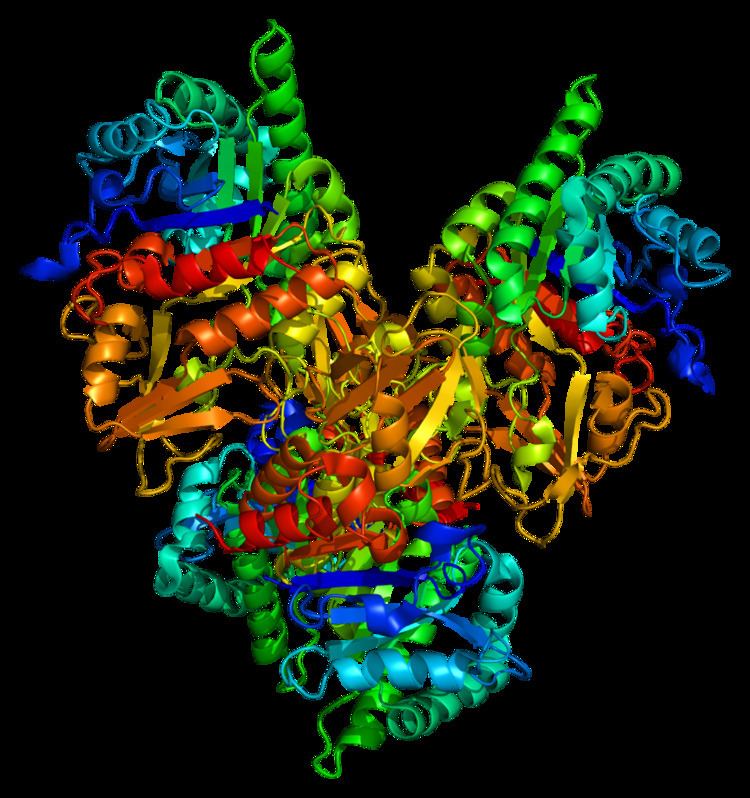Entrez 1116 | Ensembl ENSG00000133048 | |
 | ||
Aliases CHI3L1, chitinase 3-like 1 (cartilage glycoprotein-39), ASRT7, CGP-39, GP-39, GP39, HC-gp39, HCGP-3P, YKL-40, YKL40, YYL-40, hCGP-39, chitinase 3 like 1 External IDs MGI: 1340899 HomoloGene: 55569 GeneCards: CHI3L1 | ||
Chitinase-3-like protein 1 (CHI3L1), also known as YKL-40, is a secreted glycoprotein that is approximately 40kDa in size that in humans is encoded by the CHI3L1 gene. The name YKL-40 is derived from the three N-terminal amino acids present on the secreted form and its molecular mass. YKL-40 is expressed and secreted by various cell-types including macrophages, chondrocytes, fibroblast-like synovial cells, vascular smooth muscle cells and hepatic stellate cells. The biological function of YKL-40 is unclear. It is not known to have a specific receptor. Its pattern of expression is associated with pathogenic processes related to inflammation, extracellular tissue remodeling, fibrosis and solid carcinomas and asthma.
Contents
Function
Chitinases catalyze the hydrolysis of chitin, which is an abundant glycopolymer found in insect exoskeletons and fungal cell walls. The glycoside hydrolase 18 family of chitinases includes eight human family members. This gene encodes a glycoprotein member of the glycosyl hydrolase 18 family. The protein lacks chitinase activity and is secreted by activated macrophages, chondrocytes, neutrophils and synovial cells. The protein is thought to play a role in the process of inflammation and tissue remodeling. YKL-40 lacks chitinase activity due to mutations within the active site (conserved sequence: DXXDXDXE ; YKL-40 sequence: DGLDLAWL).
Regulation and mechanism
YKL-40 has been linked to activation of the AKT pro-survival (anti-apoptotic) signaling pathway. YKL-40 promotes angiogenesis through VEGF-dependent and independent pathways.
YKL-40 is a migration factor for primary astrocytes and its expression is controlled by NFI-X3, STAT3 and AP-1.
CHI3l1 is induced by a variety of cancers and in the presence of semaphorin 7A (protein) can inhibit multiple anti-tumor immune system responses. Activating an antiviral immune pathway known as the RIG-like helicase (RLH) has the ability to counter CHI3l1 induction. Cancer cells can offset RLH by stimulating NLRX1. Poly(I:C), an RNA-like molecule, can stimulate RLH activation. RLH activation can also inhibit the expression of receptor IL-13Rα2pand lmonary metastasisre. It stores NK cell accumulation and activation. It augments the expression of IFN-α/β, chemerin and its receptor ChemR23, p-cofilin, LIMK2 and PTEN and inhibiting BRAF and NLRX1 in a MAVS-dependent manner.
Cancer
It is assumed that YKL-40 plays a role in cancer cell proliferation, survival, invasiveness and in the regulation of cell-matrix interactions. It is suggested that YKL-40 is a marker associated with a poorer clinical outcome in genetically defined subgroups of different tumors. YKL-40 was recently introduced into (restricted) clinical practice. A few techniques are available for its detection.
YKL-40 is a Th2 promoting cytokine that is present at high levels in the tumor microenvironment and in the serum of cancer patients. Elevated levels of YKL-40 correlate strongly with stage and outcome of various types of cancer, which establish YKL-40 as a biomarker of disease severity. Targeting YKL-40 with neutralizing antibodies is effective as a treatment in animal models of glioblastoma multiforme.
YKL-40 also enhances tumor survival in response to gamma-irradiation.
